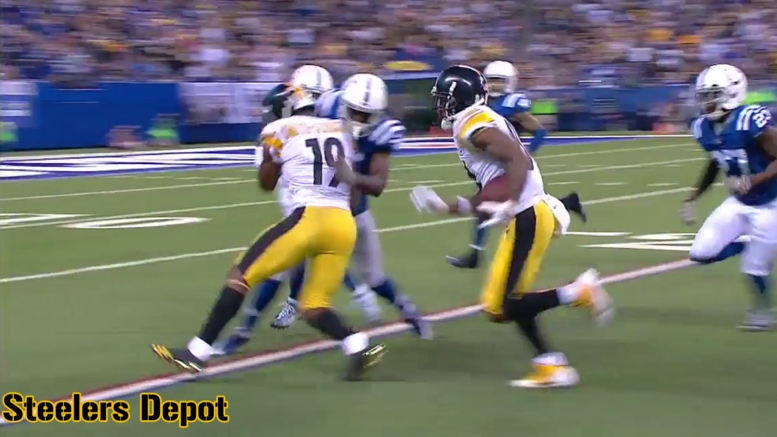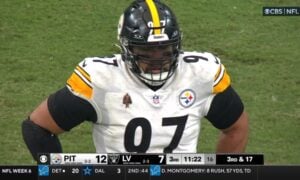2019 frustrated a lot of Steelers Nation. No one foresaw a Super Bowl run after Ben went down, but we still expected more from the offense than we got. Handicapped, yes. Comatose with occasional twitches, no. After all, James Conner had gone to the Pro Bowl in 2018. So they had the wheels. The offensive line remained uninjured, so they had the engine. Surely the team could compensate for the missing driver by leaning more on the run. Right?
Nope.
First Conner got injured, and even when he limped back on the field you could see that he needed help to make the first tackler miss. Then we saw that neither Snell nor Samuels had the pure foot speed to get off tackle. And worst of all, opposing defenses loaded the box because they had no fear of the deep passing game outside. No deep balls + no edge runs + loaded boxes = offensive stagnation. And that’s exactly what we got.
Ben’s return will eliminate the first leg of that evil triad. No one will ignore the deep ball threat when Roethlisberger’s in at QB. But a study of the offseason moves also shows that the Steelers went to great lengths to reinforce the outside running game no matter who is in at QB. Consider:
It starts with Roethlisberger. He’s back. ‘Nuff said.
Then there’s the rookie 4th rounder, Anthony McFarland Jr., one of the deadliest open space runners in college football. James Conner will be the bell cow back because he has enough juice to get outside the tackles even if it isn’t the strongest part of his game. Could McFarland challenge him? Only if the rookie proves to have the ability to run inside too. The thing to avoid is letting the personnel choices telegraph the plays. FWIW, McFarland did have some success running between the tackles in college, but one suspects he will find that a bit more challenging at the next level. And who knows? Maybe Snell will ‘pull a LeVeon’, drop 15 pounds, and discover that he can be elusive too. Regardless, the Steelers now have at least one back who can kill an opponent that’s strong up the middle but weak on the edges.
The offensive line gets honorable mention at this point. Many teams are stuck with the power game because their linemen can’t pull well enough to help. That isn’t a Steelers weakness.
The third factor is, of course, the Tight Ends. Steelers Nation has yearned after Tight Ends ever since Heath Miller retired. Vance McDonald will never be Miller, but I think it is fair to place him only a single rung down that ladder, and he’s entering his prime years of TE production. That’s okay, but those two-TE sets matter even more. So the Steelers went out and got Eric Ebron for the 1-2 TE punch. Hooray!
But, of course, Ebron often gets hit with the infamous “oversized WR” knock. He has the size, but he simply isn’t the kind of inline blocker who can hope to earn a draw against competent NFL edge setters such as Bud Dupree. Granted. But so what? His receiving skills are so good that defenses cannot assign his physical equal (a Linebacker) to the coverage duty. Eric Ebron will see no one across the line but an extraordinary Safety or a big Corner; and he blocks like a champ against opponents who are that much smaller. Call him an oversized WR all you want, but if you do it needs to come with the proviso that he’s the best blocking WR in the business.
And that, ladies and gentlemen, brings us to the observation that generated this article. The next tool for helping the outside run game is to find one of those elusive WR’s who actually have the native attitude, size, and skill to be true blocking assets. You know, the Hines Wards and Larry Fitzgeralds of the world, a/k/a the ones who, when young, excel as gunners in both directions on special teams.
The Steelers have stacked their receiving corps with exactly that kind of athlete.
Chase Claypool is 6’4″, 230+ lbs., and runs a 4.40 dash – but what did we hear as the final sentence in every scouting report during the draft season? “And he was also Notre Dame’s best special teams player regardless of position!” People used just the same words about Juju Smith-Schuster in 2017, and you found them about James Washington in 2018 as well. Plus Ebron, of course. And McDonald. This article suggests that 2020 may be the year when Pittsburgh unveils this tactic to the rest of the league.
Look deeper and you’ll find even more support. Who was this year’s big addition to the coaching staff? The new QB coach, Matt Canada. And what is his specialty? Presnap motion; used as a tool to confound defensive reads in the passing game, and also to give WR’s an angle for run blocks. His schemes mesh perfectly with WR’s who are willing to seal Safeties inside the box, cut off ILB pursuit, and even chip a Defensive End to free up the edge. In other words, during the offseason Pittsburgh collected two major on-field assets for receiver blocking (Ebron and Claypool), and also hired a master planner who knows how to use them. (See below for the fact that Pittsburgh’s coaching staff and environment know how to teach this too).
Then there’s the cherry on top: competition. The 2020 Steelers defense is built on speed, pursuit, and tackling from the inside out. They’re really, really good at it too. Devin Bush runs like the wind and racks up tackles on opponents who try to reach the edge. Terrell Edmunds runs like the wind to harvest those who get past Bush. Minkah Fitzpatrick has the knack of flashing out of nowhere to wrap up those that Edmunds may miss. Pittsburgh’s Corners (particularly Mike Hilton) take pride in doing more than just pass coverage. And all those back-7 chasers and tacklers benefit from the the team’s all-pro talent across the Front-4. It’s a perfect storm, and one of the reasons why even Baltimore could not pile up running yards against this team.
The Steelers offense will get humiliated in every practice if they try to match the defense with normal tactics. They will need those WR’s to hem in Bush, Edmunds, and those tackling Corners to avoid that. As ye practice so shall ye do. Once those receivers get used to blocking against their Pittsburgh counterparts, it is going to appear in games as well.
Can Receivers Who Block Really Make A Difference In The Run Game?
Has it really been that long since Hines Ward converted all of Steelers Nation to the One True Way? I refuse to believe that any true fan could forget either the smile or the style. Still, I suppose one must be thorough…
It comes to this. Every professional WR knows how to “run the Corners off”; i.e., to run a route that will take the defender out of the way. That fails, as it did in 2019, when opponents feel no need to honor the deep threat. Enter a man named Ben. Most solid NFL receivers also know how to “stalk block” a/k/a “block by getting in the way” or “block to achieve a tie.” This is the tactic where the WR simply stands his ground in the way of his opposing Corner, trusting in the Running Back to use his position against the defender. (FWIW, this works especially well when the offense has a shifty RB like McFarland). Those standard tactics aren’t what this article is about.
Wide Receiver’s who truly understand how to block are more than a matchup against Corners; they also help to neutralize the opponents’ real tackling machines such as LB’s and Safeties. Let me reverse the names to make the point. Every WR is willing to run downfield in an effort to tempt Joe Haden into chasing along, and the tough ones will also engage Mike Hilton in an effort to stand between him and the running lane. The specialists we are talking about go further, and limit the likes of Devin Bush, Terrell Edmunds, and Minkah Fitzpatrick. The best of them even know how to pin a Dupree or Watt inside. They are miniature TE’s in the same way that TE’s are miniature linemen, and it makes a huge difference in scheming open a running lane outside the Tackles.
Hines Ward excelled at this, as does Larry Fitzgerald today. Those types of receiver will demolish Corners, even tackling experts like today’s Mike Hilton. Small men went where Ward decided to put them. And when they line up in the slot (particularly after motioning there), these receivers use the angles to chip opposing DE’s, hold up pursuing Linebackers, and stop Strong Safeties from filling the running lane. As for Free Safeties trying to flash in for that last second rescue… just ask Ed Reed. [FN]
What happens next, when opponents finally get over the surprise of getting physically assaulted by a mere receiver? They did the only thing they could. They kept their heads on the proverbial swivel to know where the SOB was… which created hesitation, slower pursuits, and that critical extra step for even a power back like Bettis to get his shoulders headed upfield. I would guesstimate that Hines Ward’s presence on the field probably added 10-20 yards of rushing offense in every game he played. It adds up.
So why don’t all WR’s get engaged in the run game? Because defenders hate it, and make a point of getting even. In other words, it hurts. Who can forget those times when a defense caught up with Ward in the name of “payback”? He paid for his aggression, beyond any doubt – but the mere fact that they sought him out for payback added to the benefits he gave the team. Those defenders with an eye on getting Ward were the same ones who missed other players completely, not to mention getting cut-blocked by Ward himself when they lunged off balance. Blocking WR’s yield all kinds of benefits, but they remain rare because it takes a special kind of courage and grit to fight above your weight class.
Smith-Schuster, Washington, Claypool, and for the sake of discussion Ebron all have that kind of native “stuff”. They’ve got the gumption, and they’ve got the “Wanna”. As noted above, they will be playing in a scheme that will give them the opportunities too. Will they get the training?
Enter the ghost of Darryl Drake. The much-missed Coach Drake was as big an advocate of teaching WR’s to block as the game has ever known. Heck, Drake was the common thread and driving force behind the development of both Ward and Fitzgerald, and you can throw in Muhsin Muhammad as well. Double-D won’t be here to teach blocking in 2020, but his inspiration/example will. Especially since Mike Tomlin was his disciple, and both Smith-Schuster and Diontae Johnson have described themselves as more like his sons than just his students.
It should also be noted that Coach Drake always argued that good blocking skills help on the receiving side too. He taught his proteges to look on blocking as a chance to get even with physical Corners. I love that point. Most Corners expect to deliver the punishment, with the receivers having to take it. CB’s are the ones who do the tackling, and they are the ones who get to poke, punch, shove, and do everything short of grabbing at the line of scrimmage. “I was just disrupting the route, Judge.” Receivers who block get to turn those tables around both physically and mentally. A WR with actual blocking technique (hands on the inside; latch onto the breast plate; go under and up; and then drive, drive, drive with the legs) gets to poke, shove, and abuse just as much on running plays as the most physical Corner will on passing downs. Heck, he may even serve up the occasional pancake. Net result? Corners who hesitate before engaging; and that hesitation is why blocking WR’s enjoy longer careers than route running and hands could justify on their own.
Conclusion
All of that was a lot of words to describe a pretty simple message:
- The Steelers had no outside running game in 2019. Much of that had to do with the QB situation, but not all.
- Drafting McFarland is a big step, especially if he can run between the tackles in addition to “only” being a threat outside.
- Mobile OL… Check, but that has been true throughout and isn’t the issue.
- TE’s… McDonald for sure. Ebron is more of a WR who can block… but that’s exactly what we are talking about.
- WR’s who can block (including Move TE’s) make a real difference by preventing DE’s from setting the edge, cutting off LB’s in pursuit, engaging Safeties who’d fill the next gap over, and/or destroying any Corner who’s actually a threat to make the tackle. That is a new level of help compared to ‘merely’ running a defender off or stalk-blocking the Corner for a tie.
- It takes a rare WR to block at this level because it requires so much physicality and gumption. Players like Ward and Fitzgerald really do get belted by the big boys every so often.
- The Steelers have preferentially selected a who group of young receivers who have that rare combination of size, guts, physicality, and grit. They are readier and more willing to block than any WR corps I can ever remember.
- The Steelers also have coaches who emphasize WR blocking philosophically (Drake’s ghost) and as a matter of scheme (Canada and the presnap motion game).
- Learning to block will also help the young wideouts to develop as receivers, thus providing a chance to seize extra snaps in a very crowded room.
- Finally, the offense will need it’s WR’s to block in practice, or it will be humiliated on a daily basis. Still more reason for the youngsters to include blocking – real blocking – as part of their study routine.
- CONCLUSION: Expect to see a Steelers team that puts heavy, and maybe unheard of emphasis on WR’s who become active parts of the blocking scheme. Ben’s ability to hit the deep ball tones the priority down from “Vital” to just “Important,” but this could also end up being the team’s offensive signature for several years to come.
Watch for it. The Ravens revolutionized modern offense by installing a very old concept: the QB who can run. Experts will tell you that isn’t just about Lamarr Jackson’s native talents, but also the fact that running QB’s add an extra gap the defense needs to cover. It’s like adding a whole new blocker.
The Steelers could be planning to do exactly the same thing through another route: a whole group of receiving weapons that will do far more than merely getting in the way. But we could have three, four, or five extra blockers depending on the formation, not just one fragile QB who holds all the proverbial eggs.
Footnote
The Hines Ward Rule prevents receivers from blowing up defenders who do not see them coming. It does not prevent the receiver from blocking, nor from blocking successfully. The great Larry Fitzgerald has proved it no less than Ward did.








